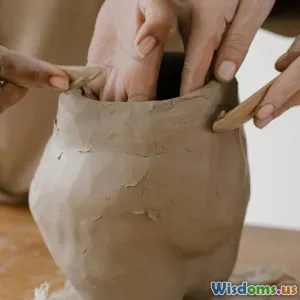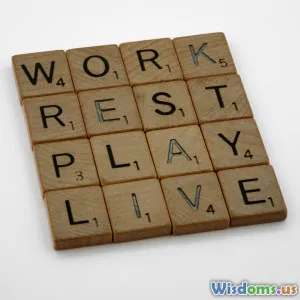
Five Handcrafting Myths That Are Holding You Back
8 min read Discover and debunk five common handcrafting myths that limit your creativity and growth in DIY and handmade projects. (0 Reviews)
Five Handcrafting Myths That Are Holding You Back
Handcrafting sparks creativity, therapeutic fulfillment, and a tangible connection to the products you use daily. Yet, many aspiring makers hesitate or feel stuck due to common misconceptions about their craft. These myths cloud judgment and limit the potential of countless DIY enthusiasts and artisans. Whether you're a beginner or seasoned creator, understanding and debunking these false beliefs can liberate your creativity and elevate your handmade projects.
In this article, we'll uncover five handcrafting myths that might be holding you back and reveal the empowering truths behind them.
Myth 1: You Need to Be Naturally Talented to Succeed
One of the most paralyzing myths is the belief that you're either born with an innate skill for handcrafting or not. This 'talent' mindset can cause novices to abandon projects prematurely or avoid trying altogether.
The Truth: Skill Can Be Learned and Improved with Practice
Creativity and craftsmanship often develop through consistent practice and learning rather than raw talent. Angela Cartwright, a renowned art educator, explains, "Experts in any field were once beginners who made mistakes, learned from them, and practiced diligently."
Consider quilting, a popular craft traditionally viewed as highly intricate. In recent years, dozens of online tutorials, podcasts, and community forums — such as the Quilt Alliance — have empowered beginners. They highlight that even the most complex patterns can be broken down into manageable steps.
A study published in the Psychology of Aesthetics, Creativity, and the Arts found that deliberate practice accounted for nearly 50% of variance in creative skill, more than inherent ability, reinforcing that talent is cultivated.
Myth 2: You Need Expensive Tools to Make Quality Handmade Items
Many artisans believe that top-tier tools and materials are prerequisites for beautiful and functional crafts, preventing budget-conscious creators from venturing into handcrafting.
The Truth: Creativity and Resourcefulness Trump Luxury Tools
While quality tools can make certain tasks easier or more efficient, they are not the secret to success. Innovators throughout history have created masterpieces with simple tools.
For example, artist and crafter Nick Ehli built a thriving woodworking workshop focused on rustic furniture using affordable power tools. He often emphasizes, "A good understanding of your craft and resourcefulness in techniques will always surpass the price tag of the tools in your hand."
Additionally, many crafts schools and online platforms stress starting with basic essentials while gradually investing in advanced tools as skills improve. This approach helps avoid unnecessary expenses and allows crafters to prioritize learning technique first.
Myth 3: Handmade Means Imperfect and Amateurish
A pervasive myth equates handmade items with low quality or flawed products. This misconception undermines the value of artisans’ time, effort, and skill.
The Truth: Handmade Can Represent Uniqueness and High Quality
Handcrafting often produces one-of-a-kind products imbued with personality and distinctive flair that mass production can't replicate. The slow and mindful process can result in meticulous detail and customized touches.
Etsy, the global online marketplace for handmade goods, has over 4.4 million active sellers (as of 2024), illustrating the vibrant demand for unique, quality handmade products worth a premium price.
Furthermore, many luxury brands emphasize limited-edition handcrafted collections, underscoring the market value of handmade as synonymous with authenticity and superior quality.
Myth 4: You Must Finish Every Project Perfectly
Perfectionism can stall creative momentum, causing unfinished projects and frustration among handcrafters.
The Truth: Progress and Learning Matter More Than Perfection
Craftsmanship is a journey rather than a one-step destination. Renowned author Elizabeth Gilbert encourages artists to move beyond fear of imperfect outcomes by reminding us that "Done is better than perfect."
Many successful creators share stories of early failures that became pivotal learning moments. For example, the viral 'failure quilt' trend on social media shows crafters embracing mistakes as unique attributes, enhancing the item's story.
Keeping this mindset encourages productivity, continuous improvement, and resilience in handcrafting.
Myth 5: Handcrafting is Only a Hobby, Not a Viable Career
This myth discourages those considering handcrafting as a professional endeavor or small business opportunity.
The Truth: Modern Platforms Make Handmade a Thriving Career
The rise of digital marketplaces like Etsy, Shopify, and handcrafted subscription boxes has revolutionized the handmade economy. Over $7 billion in gross sales were recorded on Etsy alone in 2023, reflecting expansive growth for independent artisans.
Many creators leverage social media and digital marketing to build loyal audiences globally. For instance, jewelers, ceramicists, and fibre artists have successfully turned their passion into lucrative full-time careers.
Workshops, online courses, and print-on-demand resale models also provide multiple income streams, reflecting diverse opportunities in handmade entrepreneurship.
Conclusion
Handcrafting is a deeply rewarding pursuit that connects us with creativity, sustainability, and community. However, the myths discussed here can act as invisible barriers limiting potential and progress.
By rejecting the notion that talent is fixed, expensive tools are essential, handmade means imperfect, perfection is the goal, or crafting can’t be a career, you open the door to a fulfilling journey of skill-building and creative expression.
Remember: every expert was once a beginner. Equip yourself with patience, curiosity, and the right mindset to transform how you create and perceive your handmade work. Your most inspired projects may be just a myth-busting breakthrough away.
Embark on your handcrafting adventure today—armed with truth, fueled by passion!
Rate the Post
User Reviews
Popular Posts





















